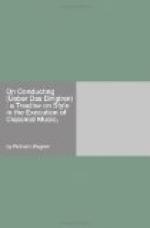As I have related, a number of Viennese amateurs who attended a performance of this poor maltreated overture, heard it rendered in a very different manner. The effect of that performance is still felt at Vienna. People asserted that they could hardly recognize the piece, and wanted to know what I had done to it. They could not conceive how the novel and surprising effect at the close had been produced, and scarcely credited my assertion that a moderate tempo was the sole cause. The musicians in the orchestra, however, might have divulged a little secret, namely this:—in the fourth bar of the powerful and brilliant entrata I interpreted the sign >, which in the score might be mistaken for a timid and senseless accent, as a mark of diminuendo [Figure: diminuendo sign] assuredly in accordance with the composer’s intentions—thus we reached a more moderate degree of force, and the opening bars of the theme were at once distinguished by a softer inflection, which, I now could easily permit to swell to fortissimo—thus the warm and tender motive, gorgeously supported by the full orchestra, appeared happy and glorified.
Our Capellmeisters are not particularly pleased at a success such as this.
Herr Dessof, however, whose business it was afterwards to conduct “Der Freyschutz,” at the Viennese opera, thought it advisable to leave the members of the orchestra undisturbed in the possession of the new reading. He announced this to them, with a smile, saying: “Well, gentlemen, let us take the overture a la Wagner.”
Yes, Yes:—a la Wagner! I believe, there would be no harm in taking a good many other things, a la Wagner! [Footnote: “Wagnerisch”—there is a pun here: wagen = to dare; erwagen—to weigh mentally: thus “Wagnerisch,” may be taken as—in a daring well considered manner.]
At all events this was an entire concession on the part of the Viennese Capellmeister; whereas in a similar case, my former colleague, the late Reissiger, would only consent to meet me half way. In the last movement of Beethoven’s A major symphony, I discovered a piano which Reissiger had been pleased to insert in the parts when he conducted the work. This piano concerned the grand preparation for the close of this final movement, when, after the powerful reiterated chords on the dominant seventh A (Breitkopf and Haertel’s Score, page 86) the figure
[Figure: musical example]
is carried on forte, until with “sempre piu forte,” it becomes still more violent. This did not suit Reissiger; accordingly, at the bar quoted, he interpolated a sudden piano, so that he might in time get a perceptible crescendo. Of course, I erased this piano and restored the energetic forte in its integrity. And thus, I presume, I again committed an offence against “Lobe and Bernsdorf’s eternal laws of truth and beauty,” which Reissiger, in his day, was so careful to obey.
After I had left Dresden, when this A major symphony came to be performed again under Reissiger, he did not feel at ease about that passage; so he stopped the orchestra, and advised that it should be taken mezzo forte!




